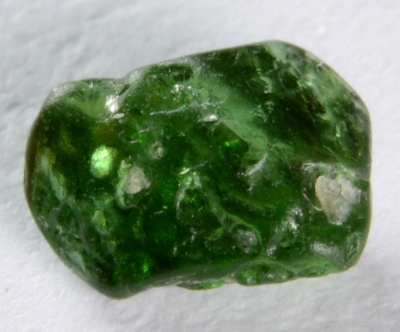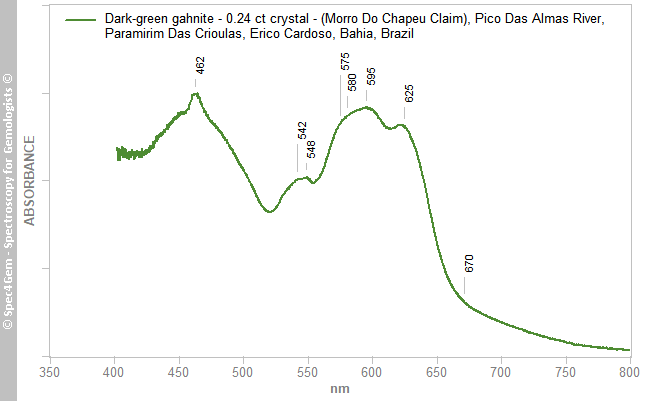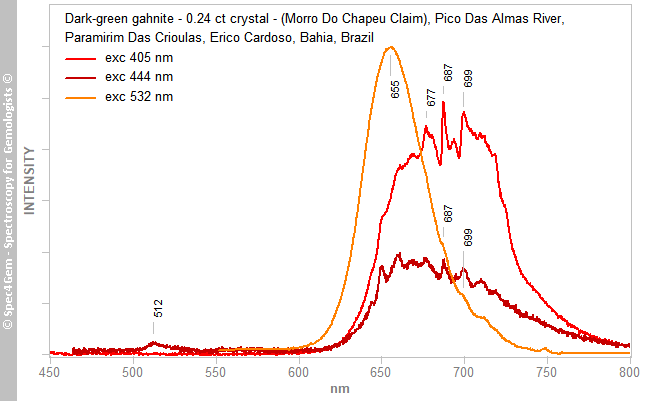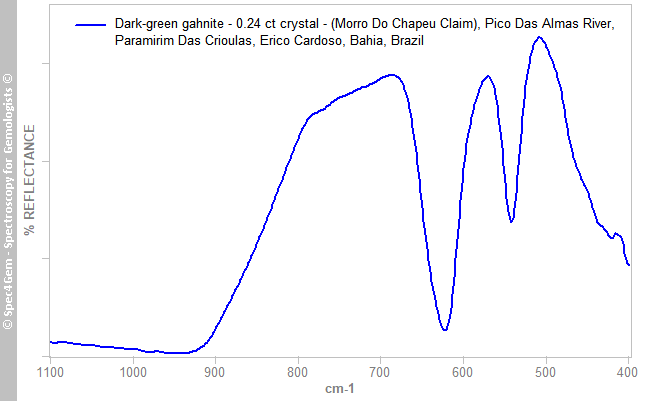Dark-green gahnite from Pico Das Almas River, Bahia, Brazil
- Details
- Created: Tuesday, 06 November 2018 21:12
This small gahnite crystal comes from the stanniferous (containing stan) alluvial deposits found at the garimpo do Morro De Chapeù (a claim where were found cassiterite, gold, diamond, spinel, bahianite, eskolaite, etc.) or in the Picos Das Almas river both located near Paramirim Das Crioulas, Erico Cardoso, Bahia, Brazil (Cassedanne & Cassedanne, 1980)[1]. It is displayed in figure 1.
It is quite unusual to find such gahnite material nowadays but it makes a very interesting case to study. Gahnite belongs to the spinel isostructural subgroup (oxyspinel group, spinel supergroup according to IMA 2018) where 28 species are identified and only 6 with predominant Al within the formula (Y-Al2O4). Among these Al-spinels, there is the spinel (commonly known in gemology) which is the magnesium member and there is the gahnite, the zinc member that is sometine found as a gemstone. Gahnite is found on the five continents but often as an opaque black material and not as a transparent gemstone as it is the case here.
 Figure 1. The 0.24 ct gahnite exibits a dark/deep green color that is
Figure 1. The 0.24 ct gahnite exibits a dark/deep green color that israther unusual in the spinel world. FOV: 4.4 mm.
| Shape | broken octahedron crystal |
| Size | 3.9 x 2.9 x 2.0 mm |
| Color | dark-green |
| Lustre | vitreous |
| Weight | 0.24 ct |
| SG | - |
| RI | - |
| DR | - |
| Pleochroism | none |
| Polariscope / Conoscope | dark over 360° -> isotropic, some inclusions show anisotropy |
| SWUV | inert |
| LWUV | inert |
| Magnetic susceptibility N52 | very slightly pulled |
| Chelsea filter | red |
Table 1. Observational and measured properties
Infrared reflectance spectroscopy:
The infrared reflectance spectra were collected from different spots on the crystal, all yielded the same spectrum pattern as shown in figure 2. Gahnite reference spectra have been rare, one was published (Brunel & Vierne, 1970)[2], the collected spectrum perfectly matched it, unambiguously identifying the 0.24 ct as gahnite. It is important to note, the spectrum significantly differ of that of spinel commonly found in gemology (see spinel database).
UV-VIS-NIR spectroscopy:
Since gahnite forms in cubic system, it is an isotropic mineral, therefore there was no need to get polarized UV-Vis-NIR spectra. The collected spectrum (figure 3) was rather complex. At a first glance, it was easy to recognize the Co2+/Fe2+ pattern in the 520-800 nm range and also the Fe3+ band at 462 nm (spinel database). The spectrum's characteristic was the wide band between 400 and 520 nm which was unsual and which formed with the Co2+/Fe2+ bands above 550 nm a transmission window centered around 520 nm giving the green color to the gemstone. The absorbance, being quite high even in the transmission window, explained the dark-green color, few light being transmitted.
 Figure 3. The Vis-NIR spectrum of the green crystal explained its dark-green color with the narrow transmission window around 520 nm. The spectrum was rather complex, the 400-520 nm range was not fully understood and the 520-800 nm range is connected to Co2+ and Fe2+.
Figure 3. The Vis-NIR spectrum of the green crystal explained its dark-green color with the narrow transmission window around 520 nm. The spectrum was rather complex, the 400-520 nm range was not fully understood and the 520-800 nm range is connected to Co2+ and Fe2+.The spinel absorption spectra have been studied for years to try to explain the right bands' assignments. Cobalt-bearing spinels have always risen interest and the cobalt spectra[3],[4],[5] are teached to new gemologist since their characteristic pattern are even clearly observable using an handheld spectroscope. Many works about iron, cobalt, chromium and even manganese interplay in the absorptions were published by Taran et al. 2009[6], D'Ippolito et al. 2013[7], 2015[8].
The bands at 542, (548), 580 and 625 nm are ascribed to d-d spin-allowed transitions 4A2(F) → 4T1(P) of tetrahedrally coordinated Co2+, and that at 575 and 595 nm are ascribed to spin-forbidden transitions 5E → 3T2 of tetrahedrally coordinated Fe2+. The band at 670 nm is ascribed to mechanisms involving Fe2+/3+ pairs. Unlike in some other spinel, the wide band at 925 nm ascribed to the spin-allowed transitions 5T2g → 5Eg of Fe2+ was not present.
As mentioned earlier, the characteristic of the spectrum was the wide band (or bands combination) between 400 and 520 nm. Verneuil synthetic grayish-blue spinel sometime shows a wide but most of time weak band either centered around 430 nm some other a narrow one around 480 nm usually attributed to Co2+. Cr3+/V3+-bearing spinel have 'globally' two bands, one at 390-420 nm and another one around 540 nm, producing the red color. In the gahnite spectrum the band seemed to be centered around 460 nm as the narrow Fe3+ 462 nm band. Was the band's side towards violet and UV real or was it an measurement error? The Cr3+/V3+ bands can mix/superimpose with Fe2/3+/Co2+ bands without being distinctively observable. Chromium is present in the area of the collection of this gahnite since chromium minerals are found there such as eskolaite, a chromium oxyde (Cr2O3)[1]. So, the cause of the color is still unclear, Fe2/3+/Co2+ or Fe2/3+/Co2+/Cr3+/V3+?
Photoluminescence spectroscopy:
The photoluminescence was studied with the three excitations sources: 405, 444 and 532 nm, the corresponding spectra are shown in figure 4. The 405 nm excitation produced an 'organ pipe' structure of emissions with multiple narrow peaks such as the 677, 687 and 699 nm ones. The organ pipe structure was rather wide compared to spinels since distinct emissions could be observed near 640, 650 and 655 nm, they were attributed to Cr3+ as for spinels. The 444 nm excitation induced the same organ pipe luminescence, significantly weaker than that induced by 405 nm source, but the most prominant peaks were the 650 and 655 nm ones. The other characteristic was the 512 nm emission in the green usually attributed to Mn2+ (4T2(4G)→6A1(6S), the absorption 6A1(6S)→4T2(4G) being between 440-460 nm). The 532 nm excitation induced a significant peak at 655 nm, that in the particular case was attributed to Co2+, weak peaks were also observed on the 655 nm peak's wing at 677, 687 and 699 nm assigned to Cr3+. Co2+ was said to be a luminescence quencher as Fe2+ and Ni2+, but according to Deren et al. 1991[9] and Sardar et al. 2002[10], Co2+ was responsible for such emission, anyway I have personally observed it only in spinels having Co2+ as shown by their absorption spectrum. It was not clear if vanadium, if present, could play a role in the emission, litterature is missing on the subject.
 Figure 4. The photoluminescence spectra demonstrated the presence of Mn2+ (512 nm), Co2+ (655 nm) and Cr3+ ( 677, 687 and 699 nm with the so characteristic 'organ pipe' pattern).
Figure 4. The photoluminescence spectra demonstrated the presence of Mn2+ (512 nm), Co2+ (655 nm) and Cr3+ ( 677, 687 and 699 nm with the so characteristic 'organ pipe' pattern).Conclusion:
Green gahnite is unusual it was worthwhile to study it, its color was not fully explained since it was not clear if Cr3+ and or V3+, and or even Mn2+ contributed to it but there is no doubt about Co2+ and Fe2+. Photoluminescence spectroscopy demonstrated the presence of Mn2+, Co2+ and Cr3+ (possibly V3+).
[1] Présence d'eskolaïte dans les alluvions stannifères de la Chapada Diamantina (Bahia˗Brésil), J. Cassedanne, J. Cassedanne, 1980, Bulletin de Minéralogie, 103-6, pp. 600-602
[2] Spectres de réflexion infrarouge de minéraux monocristallins ou en poudre II, R. Brunel, R. Vierne, 1970, Bulletin de Minéralogie, 93-3, pp. 328-340
[3] 'Cobalt-blue' Gem Spinels, J.E. Shigley, C.M. Stockton, Gems & Gemology, 1984, Spring, pp. 34-41
[4] Cobalt colored Color-Change Spinel, P. Maddisson, Gems & Gemology, 1990, Fall, pp. 226-227
[5] Cobalt-colored synthetic spinel, GRC, Gems & Gemology, 1991, Summer, pp. 113-114
[6] Optical spectroscopic study of tetrahedrally coordinated Co2+ in natural spinel and staurolite at different temperatures and pressures, M.N. Taran, M. Koch-Müller, A. Feenstra, American Mineralogist, 2009, volume 94, pp. 1647-1652
[7] Crystallographic and spectroscopic characterization of a natural Zn-rich spinel approaching the endmember gahnite (ZnAl2O4) composition , V. D'Ippolito et al., Mineralogical Magazine, 2013, Vol. 77, pp. 2941-2953
[8] Color mechanisms in spinel: cobalt and iron interplay for the blue color, V. D'Ippolito et al., Phys Chem Minerals, 2015, Vol. 42, pp. 431-439
[9] Spectroscopic properties of Co2+ in related spinels, D.K. Sardar, J.B. Gruber, B. Zandi, M. Ferry, M.R. Kokta, 2002, Journal of Applied Physics, 91(8), pp. 4846-4852
[10] The optical spectra of Co2+ in MgAl2O4 spinel, P. Deren,W. Strek, B. Jezowska-Trzebiatowska, I. Trabjerg, 1991, Journal de Physique IV Colloque, 01 (C7), pp. 279–283


